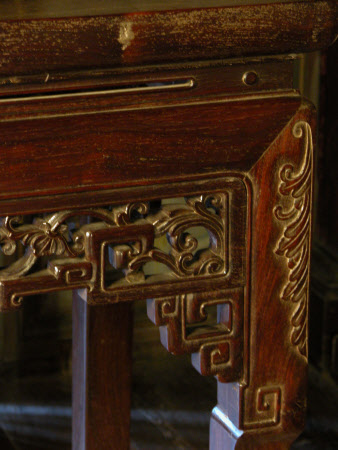Altar
Category
Furniture
Date
circa 1810 - 1816
Materials
Tielimu (Tieli wood)
Measurements
108.5 x 370.6 x 63.0 cm
Place of origin
Jingdezhen
Order this imageCollection
Knole, Kent
NT 129511
Summary
A very large tieli wood altar table, Qing Dynasty, with carved fret frieze on squared legs with scroll feet, early nineteenth century. The table is very likely to have been brought back by William Pitt Amherst, 1st Earl Amherst (1773-1857), who, in 1816, was sent to the court of China as ambassador extraordinary, although he was not admitted to Peking (Beijing) due to diplomatic disagreements.
Full description
A very large rectangular altar table, Chinese, Qing Dynasty, made of deep purplish red tieli wood, with carved fret frieze on squared legs with scroll feet, early nineteenth century. With a typical mitred, mortise and tenon-joined top with a single board floating central panel and transverse stretchers tenoned into the long rails of the frame. The outside edge of the frame cut with a simple curved moulding above a recessed waist with long pierced openings with a raised bead interspersed with raised roundels. The plain apron is mitred and half-lapped to the top of the legs with a beaded inner edge. The square section legs are double-lock mortise and tenoned into the frame of the top, and have an inward hip below the spandrel. The outer face of the knee is carved with a European style leaf motif, reflected in the pierced aprons formed of the typically highly stylised dragon motifs interspersed with leaves also in a European style. The table is very likely to have been brought back by William Pitt Amherst, 1st Earl Amherst (1773-1857), who, in 1816, was sent to the court of China as ambassador extraordinary, although he was not admitted to Peking (Beijing) due to diplomatic disagreements. It is first listed in the 1837 inventory of Knole inside the Cartoon Gallery in the same place, where it is still today: ‘[A] Long Solid Rose wood table, with Carved legs’, and again, always in the same place, in the 1861 inventory (‘[A] Long Solid Rosewood table with carved legs’) and in that of 1911 (‘A 12 ft Rosewood Chinese Sideboard finely carved figure on 4 square legs’). How exactly the massive Chinese altar table came to the house remains a mystery. Over 12 feet long, the piece of furniture must have been transported in a huge crate, as no European cabinetmaker would ever have been able to dismantle and reassemble the traditional Chinese construction of the table, perfected since the 12th century. Amherst – like the 6th Earl of Dorset, the 3rd Duke of Dorset and 1st Earl Whitworth, another ambassador to have retired at Knole – is said to have refused to prostrate himself in front of the Emperor of China, which led to the ruler’s refusal to grant him an audience. Amherst then embarked on a four-month tour across the Chinese provinces, before returning home. Astonishingly, on the journey back, the lead ship, H.M.S. Alceste, sank, which means that the crate must have voyaged on the second ship, the H.M. Brig Lyra. Clarke Abel’s ‘Narrative of a Journey in the Interior of China and of a Voyage to and from that Country in the Years 1816 and 1817’ (London, 1818) describes Amherst’s embassy in great detail and makes numerous references to ceramics, which Amherst saw, but hardly any to furniture: ‘The city of Nan-chang-foo is famous for shops of porcelain, and gave us many opportunities of examining splendid vases formed of the finest quality of this celebrated ware.’ (p. 173). Clarke also raises the issue of transportation: ‘The shops in which the porcelain was sold were capacious, and very neatly fitted up. Indeed I scarcely recollect seeing any spectacle in China that gratified me more than a first-rate porcelain warehouse. The various articles of all forms, dimensions, and colours, were so arranged as to produce the best effect. Our purchases were inconsiderable, in consequence of the difficulty of transporting such brittle goods, and of the usual exactions of the soldiers. The prices asked for the large vases were from fifty to eighty Spanish dollars.’ (p. 174). The Knole table’s timber, tielimu (tieli wood), comes from the tallest of all hardwood trees and is the least expensive. In Sir Percival David’s posthumously published 1971 ‘Chinese connoisseurship: the Ko Ku Yao Lun. The essential Criteria of Antiquities’ (a translation of the Chinese text of 1388), it is said that ‘the natives of Dongguan county [in Guangdong province] often used tielimu for building houses’ (see Wang Shixiang, Connoisseurship of Chinese Furniture, Ming and Early Qing Dynasties, Chicago 1990, vol. 1, p. 151). The table also shows distinct European influences in its ornamentation, which were particularly fashionable at the turn of the 18th to the 19th century, after the Qianlong Emperor (1711-1799) had built his European style palace, Yuan Ming Yuan, destroyed by British and French forces during the Second Opium War in 1860, and known only through engravings and architectural fragments.
Provenance
Very likely to have been acquired by William Pitt Amherst, 1st Earl Amherst, ambassador extraordinary to China in 1816. First recorded in the Cartoon Gallery at Knole in 1837 and in the same location ever since. Knole and the majority of its furniture were accepted by HM Treasury in part payment of death duties and transferred to the National Trust in 1946.
References
Wang Shixiang, Connoisseurship of Chinese Furniture, Ming and Early Qing dynasties, Chicago 1990

